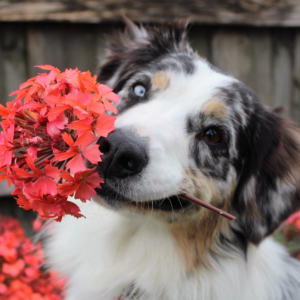 As spring arrives and the first buds appear, gardening can be a relaxing and healthy way to pass the time. But it can also pose some potential risks to our cat and dog friends. With care and some knowledge, these risks can be avoided. Here is a list of potential spring garden hazards.
As spring arrives and the first buds appear, gardening can be a relaxing and healthy way to pass the time. But it can also pose some potential risks to our cat and dog friends. With care and some knowledge, these risks can be avoided. Here is a list of potential spring garden hazards.
Fertilizers and Pesticides:
Fertilizers containing blood meal, bone meal, feather meal or iron can be tasty for dogs and particularly dangerous. Ingestion of large amounts of meal containing products can form concretions in the stomach resulting in obstruction and severe pancreatitis. Likewise, those containing iron can lead to iron poisoning causing vomiting, bloody diarrhea, lethargy, abdominal pain, shock, tremors, and potential cardiac and liver effects. Consider using natural fertilizers available many garden supply stores or local farms. Ingestion of pesticides or insecticides containing organophosphates can be life threatening even in small amounts.
Mulch:
Cocoa mulch is made from the discarded shells and hulls of the cocoa bean. Its chocolate like smell can be particularly attractive to dogs. Similarly, like chocolate, this mulch contains theobromine and caffeine. The amount of toxin present can vary from product to product. Symptoms of toxicity include vomiting, diarrhea, hyperactivity, abnormal heart rhythm, seizures and in extreme cases, death. Keep pets safe by closely supervising them or using safer alternatives to cocoa mulch. They include rubber mulch, cedar mulch, leaves, pine needles or untreated wood chips. While these are safer alternatives, please remember these can still be ingested and cause an obstruction.
Compost:
Gardeners love compost for its nutrient value and many have their own pile. Compost can be toxic to pets and wildlife and should always be fenced off. As organic matter decomposes in the compost pile, molds can grow. Consequently, these molds can produce tremorgenic mycotoxins. As a result, when ingested symptoms can occur within 30 minutes and include agitation, panting, drooling, vomiting, tremors, and seizures. However, with supportive care the prognosis is good.
Snail and Slug Bates:
These are available in pellets, granules, powder or liquid. Most contain metaldehyde which is very dangerous to dogs and cats. As a result, symptoms can occur within 1-2 hours of ingestion and include salivation, restlessness, vomiting, tremors, seizures and increase body temperature. Without veterinary care the symptoms can last for days and be fatal, for instance. Gopher, mole and other vermin bates contain strychnine and are highly toxic.
Flowers and Plants:
Many plants can be toxic to pets. Some can have only mild symptoms of gastrointestinal upset to severe liver or kidney failure and death. For example, the following is an incomplete list of common plants.
- Severe toxicity: Sego palm, Azalea/Rhododendron, Caster bean, Cyclamen, Oleander and Yew.
- Moderate Toxicity: Aloe Vera, Amaryllis, Begonia, Chrysanthemum, Daffodil, Hosta, Morning glory and Poinsettia.
- Mild toxicity: Baby’s breath, Carnation, Gladiola and Tomato plant.
Citronella candles:
Ingestion of citronella candles, used to deter mosquitos, can cause gastrointestinal inflammation including vomiting and diarrhea.
Above all, if you think your pet has ingested a toxic substance, contact your veterinarian for advice and treatment. Additionally, you can contact the ASPCA Hotline at 1-888-426-4435 or the Pet Poison Hotline at 1-800-213-6680. Both charge a fee for their service. Several pet poison apps are available, as well.
In conclusion, contact or visit North Fulton Feed for additional information.
Article provided by Nutrena.
